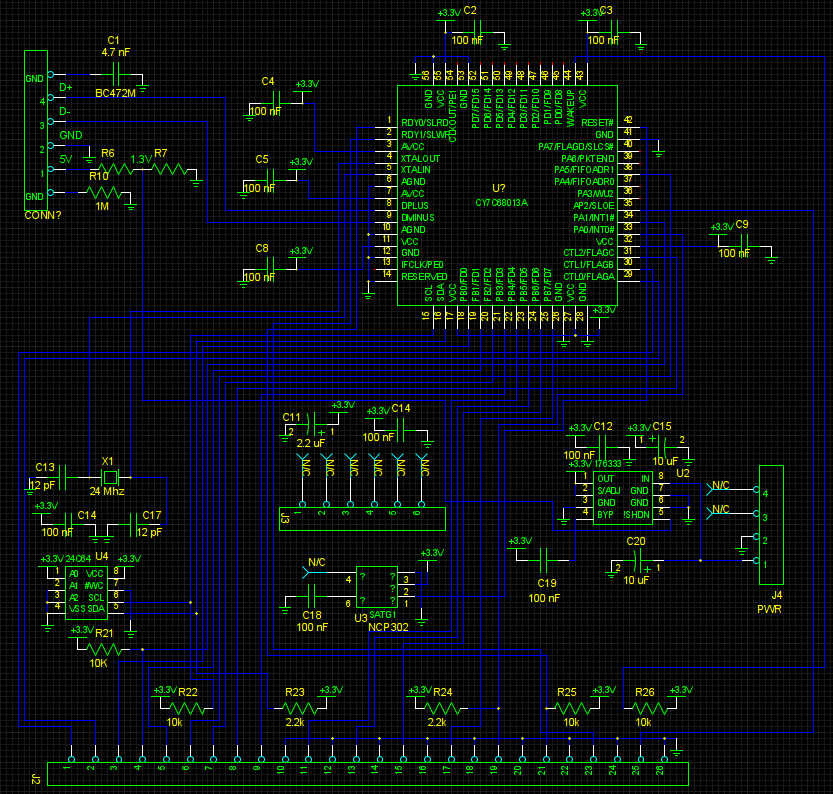BPM WWAVUSBEPP
Background
At one point they sold an upgrade board to convert older programmers to USB. Basically what it boils down to is:
- The adapter should work for BP-1400, BP-1600, BP-1700, and (some?) EPP series programmers
- You can swap it from one unit to another (ex: swap from BP-1410 to BP-1600 to upgrade an old unit)
- Units known to ship with this adapter
- BP-1410 (probably BP-1610 and BP-1710 as well)
- Silicon Sculptor 3
- The adapter is no longer offered as an upgrade for the BP-1×00 models
- 2.4 Mb/s to 9.0 Mb/s potential speed upgrade
- 14. What programming site models will this work with?
- All EPP programmers. This encompasses 6th-gen and 7th-gen.
- This may be a different adapter board
- 17. About how much will these adapters cost to make?
- About $20 in materials
- 21. Why can’t I just buy an off-the-shelf USB-Parallel port adapter and use that?
- There is no formal specification as to what you must do with these signals. Printer makers adhere to an informal standard as to what each of these signals does, but such functionality isn’t suitable for device programmers.
- Even if the vendor-defined signals didn’t get in the way, the performance of any off-the-shelf adapter would be horrible (much worse than parallel port)
- 20. What are the Macola part numbers of the site adapter and the hub?
- Site Adapter: WWAVUSBEPP
- Hub: WWAVUSBHUB
>> All I have is an Actel Silicon Sculptor 3, also made by BP Micro,>> that looks like the BP-1710 (with the 'START' button) but connects>> via a USB port. On the main PCB of the BP-1600 and the SS3 are two,>> 2 row, 26 pin, connectors, one toward the back edge of the PCB toward>> the back panel and the other just inside the first connector. The>> inside connector directly connects to the parallel port on the back>> of the BP-1600. On the SS3, there is a small PCB that plugs into the>> same connector, takes a power input, and also has 6 pin connections>> to the other 26 pin connector. This small PCB has a USB connector>> that is> connected to the back of the SS3 as the USB connection.>>
Other:
- It's part number is WWAVUSBEPP
From another doc:
> Automated Programming System users can determine if the handler is configured with the USB to EPP adapter through the PC Device Manager. If “BP Microsystems SPC Interface” is present as shown in the object below, then the USB to EPP adapter is already installed. If not, please contact BPM Microsystems Sales to order an upgrade kit part number: WHARUSBSPCKIT.
Programmer compatibility
Trying a 1600 with the adapter under 5.33.0 (last version to support parallel) worked fine. However, under 5.47.0 (newest release version as of today):
I analyzed the USB packet traces for kicks to see what was happening. There are some minor differences (ex: later software chunks firmware load up smaller) but otherwise they are identical in purpose. However, the newer software seems to just give up at one point. My guess is that they removed the 1600 handling code, not just the parallel interface to it.
CPCBD03223 Rev F (BP-1410)
Original unit was from
Power to J4
CPCB12A Rev C motherboard (BP-1600, SS2)
Connect to TERM 1 (J11). TERM 2 (J12) will not work)
PCB overview
Above:
- ASSY No. WWAVUSBEPP
- EPCBD03181 Rev C
Where
NOTE: a number of the component values above are best guesses. In particular:
- R6/R7 divider
- Most small capacitors. T13/T17 are recommended values from cypress datasheet
- U3 is best guess
More info here: [3]
2015-04-24: tried plugging the adapter from my BP-1410 into my BP-1600 and it worked!
CY7C68013- 56LFC 0421 E 04 CYP 626381 KOR
U2 (?):
LT 515 176333
U3 (?):
U4 (8KB I2C EEPROM):
24C64W6 ST K414B
Pinout
| Pin | Dbg color | MCU pin | Function | PU/PD | |
|---|---|---|---|---|---|
| 1 | Black | 30: CTL1/FLAGB | |||
| 2 | Black | 29: CTL0/FLAGA | |||
| 3 | Brown | 18: PB0/FD0 | |||
| 4 | Brown | 34: PA1/INT1# | PU | ||
| 5 | Red | 19: FB1/FD1 | |||
| 6 | Red | 38: PA5/FIFOADR1 | |||
| 7 | Orange | 20: FB2/FD2 | |||
| 8 | Orange | 31: CTL2/FLAGC | |||
| 9 | Yellow | 21: PB3/FD3 | |||
| 10 | Yellow | N/A | GND | ||
| 11 | Green | 22: PB4/FD4 | |||
| 12 | Green | N/A | GND | ||
| 13 | Blue | 23: PB5:FD5 | |||
| 14 | Blue | N/A | GND | ||
| 15 | Violet | 24: PB6/FD6 | |||
| 16 | Violet | N/A | GND | ||
| 17 | Black | 25: PB7/FD7 | |||
| 18 | N/C | N/A | GND | ||
| 19 | Brown | 33: PA0/INT0# | PU | ||
| 20 | N/C | N/A | GND | ||
| 21 | Red | 1: RDY0/SLRD | PU | ||
| 22 | N/C | N/A | GND | ||
| 23 | Orange | 2: RDY1/SLWR | |||
| 24 | N/C | N/A | GND | ||
| 25 | Yellow | 35: AP2/SLOE | |||
| 26 | N/C | N/A | GND |
Resistor placed sub-optimially. is there another pullup?


